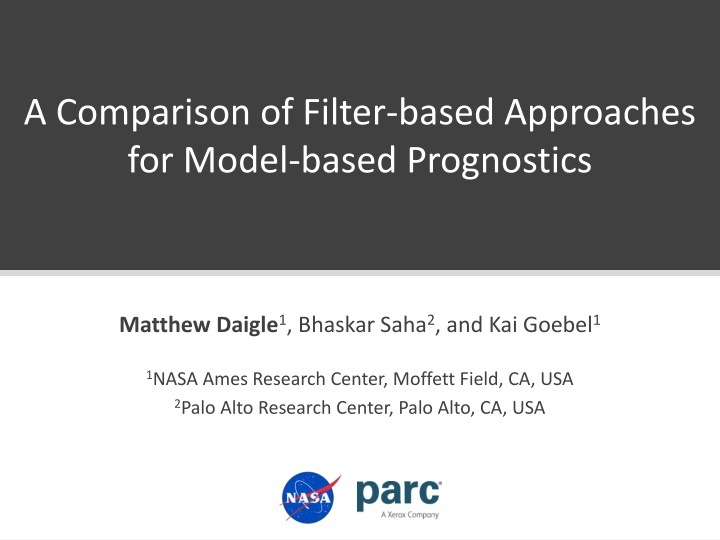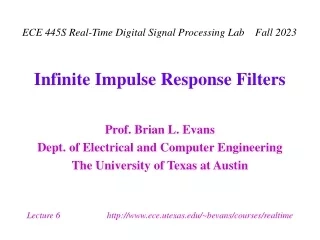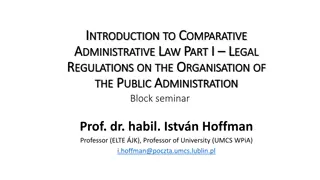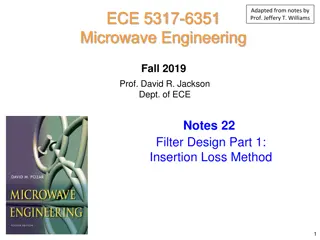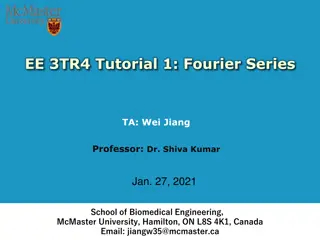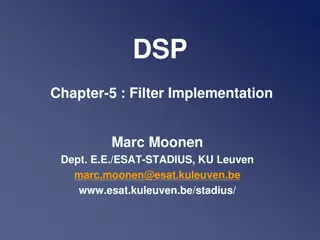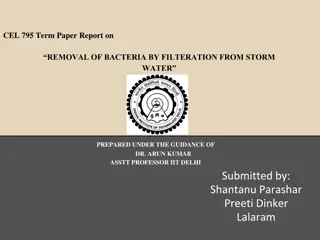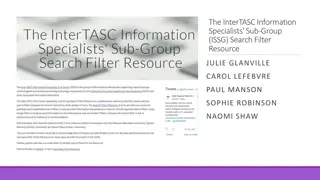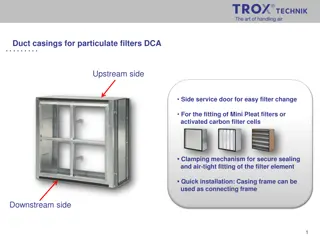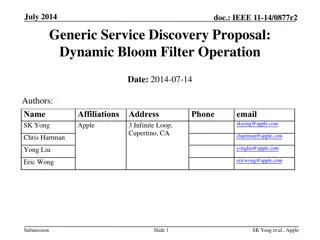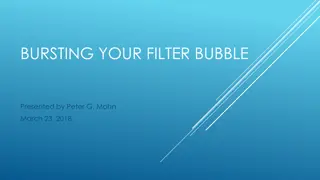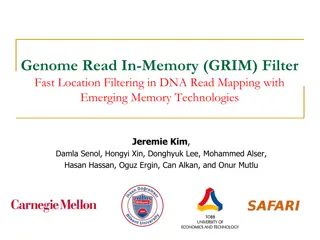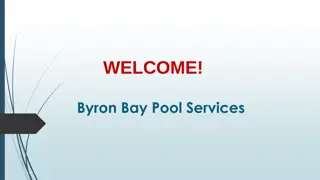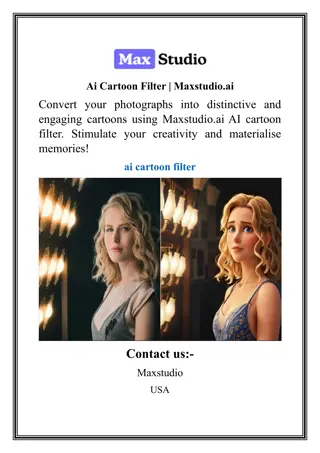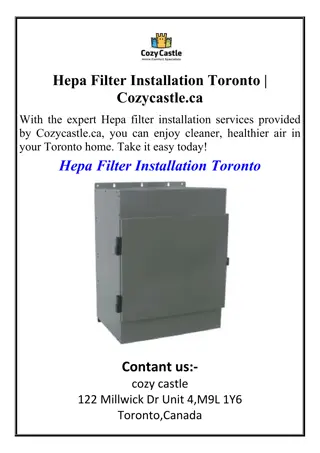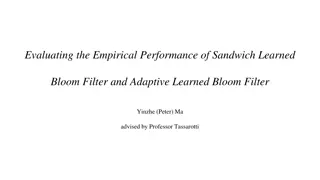Filter-based Approaches for Model-based Prognostics Comparison
Prognostics involves estimating end of life and remaining useful life for condition-based maintenance in various domains. This study compares Daum, unscented Kalman, and particle filters for practical application and prognostics performance.
Uploaded on Feb 18, 2025 | 0 Views
Download Presentation

Please find below an Image/Link to download the presentation.
The content on the website is provided AS IS for your information and personal use only. It may not be sold, licensed, or shared on other websites without obtaining consent from the author.If you encounter any issues during the download, it is possible that the publisher has removed the file from their server.
You are allowed to download the files provided on this website for personal or commercial use, subject to the condition that they are used lawfully. All files are the property of their respective owners.
The content on the website is provided AS IS for your information and personal use only. It may not be sold, licensed, or shared on other websites without obtaining consent from the author.
E N D
Presentation Transcript
A Comparison of Filter-based Approaches for Model-based Prognostics Matthew Daigle1, Bhaskar Saha2, and Kai Goebel1 1NASA Ames Research Center, Moffett Field, CA, USA 2Palo Alto Research Center, Palo Alto, CA, USA
Motivation Prognostics is the problem of estimating end of life (EOL) and remaining useful life (RUL) Key to condition-based maintenance Applications in many domains including aerospace Model-based prognostics approach consists of Damage estimation a joint state-parameter estimation problem Prediction projects current joint-state parameter distribution into the future to determine EOL Damage estimation phase is typically performed through the use of a filter Exact filters (e.g., Kalman, Benes, Daum filters) Approximate filters (e.g., extended Kalman, unscented Kalman, and particle filters) Compare Daum, unscented Kalman, and particle filters, in terms of practical application and prognostics performance 3/7/2012 2012 IEEE Aerospace Conference 2
Outline Problem Formulation Model-based Prognostics Architecture Damage Estimation Daum Filter Unscented Kalman Filter Particle Filter Prediction Case Study: Centrifugal Pump Conclusions 3/7/2012 2012 IEEE Aerospace Conference 3
Problem Formulation Prognostics goal Compute EOL = time point at which component no longer meets specified performance criteria Compute RUL = time remaining until EOL System model Input Process Noise State Parameters Sensor Noise Output Define threshold from performance specs that is 1 when system is considered failed, 0 otherwise EOL and RUL defined as Compute and/or 3/7/2012 2012 IEEE Aerospace Conference 4
Defining EOL Failure threshold TEOL defined with functional specifications and linked to boundary in multi- dimensional damage space Beyond the boundary, the component does not conform to functional specifications Within the boundary, the component is still functioning properly From time t0 to prediction time tP, system behaves within specs Interested at what time t system will exit this region May use this information to find time t >t at which system exits the region 3/7/2012 2012 IEEE Aerospace Conference 5
Prognostics Architecture 1 2 System receives inputs, produces outputs Identify active damage mechanisms Fault Detection Isolation & Identification F Prognostics uk yk p(xk, k|y0:k) p(EOLk|y0:k) Damage Estimation System Prediction p(RULk|y0:k) 3 4 Predict EOL and RUL as probability distributions Estimate current state and parameter values 3/7/2012 2012 IEEE Aerospace Conference 6
Damage Estimation Damage estimation computes an estimate of the state-parameter distribution given the inputs and outputs of the system Several algorithms solve this problem We focus here on filtering approaches Filtering approaches are based on an underlying model of the system For prognostics, these underlying models are almost always nonlinear, because the damage progression models are nonlinear Further, adding unknown parameters as states almost always creates a nonlinear system Therefore, nonlinear filters are required Filters possess different features Exact vs approximate Class of dynamics handled Type of noise handled (additive vs multiplicative, Gaussian vs non-Gaussian) Deterministic vs stochastic 3/7/2012 2012 IEEE Aerospace Conference 7
Daum Filter The Daum filter is an exact nonlinear filter for a certain class of nonlinear dynamics Brownian process noise, Gaussian sensor noise Dynamics restricted to satisfy several assumptions Must exist a function (x,t) where Must exist A, b, c, D, E to satisfy 3/7/2012 2012 IEEE Aerospace Conference 8
Daum Filter Given these assumptions (and a few others) where m and P are filter variables, analogous to mean and covariance Filter equations look similar to Kalman filter equations The main advantages are that the filter is exact and has low computational complexity The main disadvantage is that the class of dynamics it covers is very restrictive in practice An approximate version exists but (x,t) is still needed 3/7/2012 2012 IEEE Aerospace Conference 9
Unscented Kalman Filter The UKF is an approximate nonlinear filter, and assumes additive, Gaussian process and sensor noise Handles nonlinearity by using the concept of sigma points Transform mean and covariance of state into set of samples, called sigma points, selected deterministically to preserve mean and covariance Sigma points are transformed through the nonlinear function and recover mean and covariance of transformed sigma points x x Pxx Pxx Unscented transform x Symmetric Unscented Transform Number of sigma points is linear in the size of the state dimension In comparison, Kalman and Daum filters effectively use one sigma point 3/7/2012 2012 IEEE Aerospace Conference 10
Unscented Kalman Filter Kalman filter equations extended to use sigma points Prediction Step Update Step Has medium computational complexity and covers a very large class of dynamics, but is an approximate filter 3/7/2012 2012 IEEE Aerospace Conference 11
Particle Filter Particle filters can be applied to general nonlinear processes with non-Gaussian noise does not restrict the dynamics in any way But is an approximate filter, and is stochastic in nature Approximate state distribution by set of discrete weighted samples (i.e., particles): State represented with discrete probability distribution w x Suboptimal, but approach optimality as N Approximates posterior as Distribution evolves in time t 3/7/2012 2012 IEEE Aerospace Conference 12
Particle Filter Begin with initial particle population Predict evolution of particles one step ahead Compute particle weights based on likelihood of given observations Resample to avoid degeneracy issues Degeneracy is when small number of particles have high weight and the rest have very low weight Avoid wasting computation on particles that do not contribute to the approximation w w w w x x x x Initial Particle Population Predict Evolution Compute Weights Resample 3/7/2012 2012 IEEE Aerospace Conference 13
Joint State-Parameter Estimation Joint state-parameter estimation is performed within a filtering framework by augmenting the state vector with the unknown parameter vector Must assign an evolution to the parameters, typically a random walk The particle filter adopts this equation directly, but for the Daum and UKF filters, it is represented in the corresponding diagonal of the process noise matrix Selection of variance of random walk noise is important Variance must be large enough to ensure convergence, but small enough to ensure precise tracking Optimal value depends on unknown parameter value Should tune online to maximize performance 3/7/2012 2012 IEEE Aerospace Conference 14
Variance Control values tuned initially for maximum possible wear rates Try to control the amount of relative spread of parameter estimate to a desired level (e.g., 10%) Since it is relative, applies equally to any wear parameter value Can use relative median absolute deviation (RMAD), relative standard deviation (RSD), among others Several stages to control adaptation Convergence: Control to large spread (eg 50%) until threshold reached (eg 60%) Tracking: Control to desired spread (eg 10%) Control based on percent error between actual spread and desired spread with parameter P Increase random walk variance if parameter variance is too low, else decrease Proportional control based on error between actual and desired relative spread Move to next stage when threshold crossed 3/7/2012 2012 IEEE Aerospace Conference 15
Prediction Sample from the state-parameter distribution, and simulate each sample forward to EOL For PF and UKF, use particles/sigma points directly Hypothesized inputs Sample simultaneous progression of thrust bearing and radial bearing wear in a centrifugal pump 3/7/2012 2012 IEEE Aerospace Conference 16
Case Study: Centrifugal Pump Apply framework to centrifugal pump Complex electro-mechanical devices used for fluid delivery in water systems, spacecraft fueling, etc. Often undergo continuous usage, so require regular maintenance Provide a critical function, so failures can cause loss of mission Centrifugal pump operation Fluid enters the inlet, impeller rotation forces fluid through the outlet Impeller rotation driven by electric motor Bearings help minimize friction Bearing housing contains lubricating oil Wear rings prevent excessive internal leakage Outlet Bearing Housing Shaft Coupling Motor Pump Casing Wear Rings Inlet Impeller Thrust Bearings Radial Bearings Volute Seal Centrifugal Pump 3/7/2012 2012 IEEE Aerospace Conference 17
Centrifugal Pump Modeling Impeller rotation governed by Motor torque (driven by input voltage and line frequency) Friction torque Load torque (function of impeller speed and fluid flow) Pump flow determined by Pump pressure (function of impeller speed) Suction and discharge pressures (inputs to this model) Internal leakage flow Pump temperatures governed by Heat transfer between bearings, oil, and environment Heat due to friction Failure defined by limits on pump efficiency and pump temperatures Sensors measure impeller speed, discharge flow, and bearing and oil temperatures 3/7/2012 2012 IEEE Aerospace Conference 18
Modeling Damage Impeller damage characterized by decrease in impeller area, caused by erosive wear due to the flow Decreases pump efficiency 13 Impeller Area (m2) 12 11 10 9 0 5 10 15 20 25 30 35 40 Thrust Bearing Friction Coefficient (Nms) Time (hours) -6 x 10 3.5 3 Thrust and radial bearing damage characterized by increases in friction coefficients, caused by bearing wear due to sliding and rolling friction Increases bearing temperatures 2.5 2 1.5 1 0 5 10 15 20 25 30 35 40 Time (hours) Radial Bearing Friction Coefficient (Nms) -6 x 10 5 4 3 2 1 0 5 10 15 20 25 30 35 40 Time (hours) 3/7/2012 2012 IEEE Aerospace Conference 19
Evaluation Metrics For estimation accuracy, use percent root mean square error (PRMSE) of wear parameter For estimation spread, use relative standard deviation (RSD) For prediction accuracy, use relative accuracy metric1 (RA) where RULkp* indicates true RUL For prediction spread, use RSD Relative accuracy1 (RA), where RULkp* indicates true RUL Experiments Daum filter is not applicable to the dynamics of the pump, so apply only to PF and UKF Wear parameters for damage modes selected randomly within ranges Number of particles varied Level of sensor noise varied 1 Saxena et al. IJPHM 2010 3/7/2012 2012 IEEE Aerospace Conference 20
Results Wear Parameter Estimation: UKF Wear Parameter Estimation: PF Fast convergence, small spread, and good accuracy. Slower convergence, larger spread, and comparable accuracy. 3/7/2012 2012 IEEE Aerospace Conference 21
Results Prediction: UKF =10%, =50% Prediction: PF =10%, =50% Predictions based on UKF estimates have a larger amount of the RUL distribution within the desired bounds. Accuracy based on the means are comparable. Sigma point predictions require only 23 simulations, compared to the 500 for the particle filter. 3/7/2012 2012 IEEE Aerospace Conference 22
Results Overall, UKF was more accurate and precise, and behaved better with higher levels of sensor noise UKF outperforms the PF with much fewer computations But, UKF cannot be applied to all systems Overall Results: UKF Overall Results: PF 3/7/2012 2012 IEEE Aerospace Conference 23
Conclusions Described model-based prognostics framework using filters for the damage estimation step Compared three different filters covering features like exact vs approximate and deterministic vs stochastic For prognostics, nonlinear filters are almost always required Although the Daum filter has some nice properties, it was found to be inappropriate for the pump, and likely for many practical systems for prognostics UKF is applicable to the pump and outperformed the PF in all respects, but the PF captures any type of dynamics (even mixed continuous/discrete) so has the highest level of applicability Future work Investigate the approximate version of the Daum filter Investigate other exact filters Determine whether additional effort required for Daum filter is justified by the possible gain in performance 3/7/2012 2012 IEEE Aerospace Conference 24
